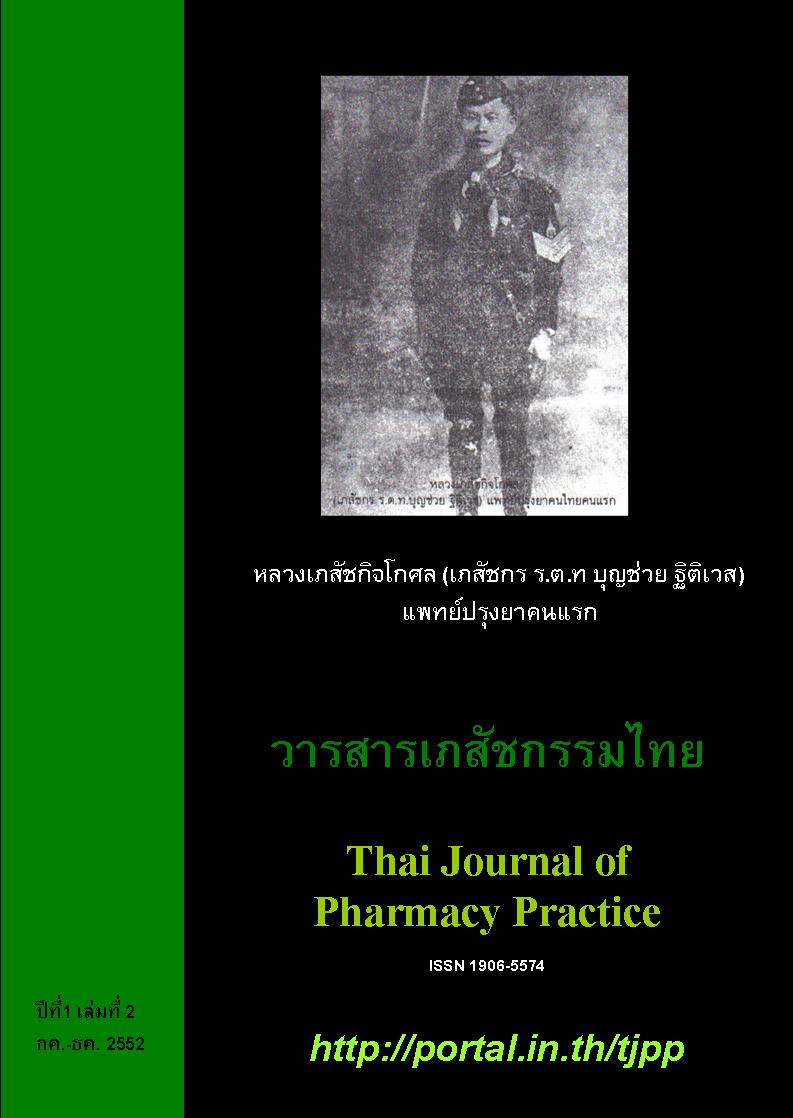ปัจจัยที่มีผลต่อความผูกพันต่อองค์กรของผู้แทนยา
Main Article Content
บทคัดย่อ
วัตถุประสงค์ : เพื่อศึกษาปัจจัยที่สัมพันธ์กับความผูกพันต่อองค์กรของผู้แทนยา วิธีการวิจัย : เครื่องมือการวิจัยคือแบบวัดตัวแปรอิสระดังนี้ แบบวัดภาระงาน การสนับสนุนจากหัวหน้างาน และเพื่อนร่วมงานของ Caplan และคณะ แบบวัดการใช้ทักษะในการทำงานและความขัดแย้งในองค์กรของ Leiter แบบวัดการสนับสนุนจากครอบครัวของ Moos และ Moos แบบวัดความซ้ำซากของงาน Price และ Mueller แบบวัดความขัดแย้งของบทบาทของ Rizzo และคณะ แบบวัดความมีอิสระในงานของ Breaugh และแบบวัดความพึงพอใจต่อรายได้ของ อนันต์ รุ่งผ่องศรีกุล การวัดตัวแปรตามใช้แบบวัดความผูกพันต่อองค์กรแบบสามมิติของ Meyer, Allen และ Smith แบบวัดการคิดลาออกจากงานเป็นของ Mobly และคณะ และแบบวัดความไม่พึงพอใจของ Caplan และคณะ ตัวอย่างคือผู้แทนยา 400 คนทั้งที่เป็นเภสัชกรและไม่เป็นเภสัชกร ที่เลือกมาแบบตามสะดวก ผู้กระจายแบบสอบถามคือผู้วิจัยและเภสัชกรประจำคลังยาของโรงพยาบาลสองแห่ง ตัวอย่างส่งแบบสอบถามคืนทางไปรษณีย์มายังผู้วิจัยหรือส่งให้เภสัชกรโดยตรง ผลการวิจัย : อัตราการตอบแบบสอบถามคิดเป็นร้อยละ 68.75 (N=275) ตัวอย่างร้อยละ 34.6 เป็นเภสัชกร ความผูกพันต่อองค์กรทั้งสามด้าน และความคิดลาออกจากงานของตัวอย่างอยู่ในระดับปานกลาง (คะแนนเฉลี่ย 2.90-3.35 จากคะแนนเต็ม 5) ส่วนความไม่พึงพอใจในงานอยู่ในระดับต่ำ (2.02+0.73) ตัวแปรอิสระทั้งหมดสามารถอธิบายการผันแปรของความผูกพันต่อองค์กรด้านจิตใจ ด้านผลประโยชน์ และด้านบรรทัดฐาน และความไม่พึงพอใจในงานได้ร้อยละ 27.9, 10.3, 12.4 และ 20.3 ตามลำดับ ตัวแปรที่มีอิทธิพลต่อความผูกพันทั้งทางด้านจิตใจและด้านบรรทัดฐานคือ ความพอใจต่อรายได้ ความซ้ำซากของงาน ความขัดแย้งของบทบาท และความขัดแย้งภายในองค์กร ตัวแปรที่มีอิทธิพลต่อความผูกพันด้านผลประโยชน์คือ การสนับสนุนจากหัวหน้างาน การใช้ทักษะในการทำงาน และความขัดแย้งของบทบาท ความผูกพันต่อองค์กรทำนายการคิดออกจากงานได้ดีกว่าความไม่พึงพอใจในงาน สรุป : การวิจัยพบว่ามีตัวแปรคุณลักษณะงานหลายตัวที่ทำนายความผูกพันต่อองค์กรได้ การพัฒนาความผูกพันต่อองค์กรควรมุ่งปรับปรุงคุณลักษณะงานต่าง ๆ เหล่านี้
Article Details
ผลการวิจัยและความคิดเห็นที่ปรากฏในบทความถือเป็นความคิดเห็นและอยู่ในความรับผิดชอบของผู้นิพนธ์ มิใช่ความเห็นหรือความรับผิดชอบของกองบรรณาธิการ หรือคณะเภสัชศาสตร์ มหาวิทยาลัยสงขลานครินทร์ ทั้งนี้ไม่รวมความผิดพลาดอันเกิดจากการพิมพ์ บทความที่ได้รับการเผยแพร่โดยวารสารเภสัชกรรมไทยถือเป็นสิทธิ์ของวารสารฯ
เอกสารอ้างอิง
2) Johnston MW, Marshall GW. Sales force management. 7th ed. Boston:McGraw-Hill; 2003.
3) Vinchur AJ, Schippmann JS, Switzer III FS, Roth PL. A meta-analytic review of predictors of job performance for salespeople. J Appl Psychol 1998;83:586–97.
4) Jaramilloa F, Mulkib JP, Marshallc GW. A meta-analysis of the relationship between organizational commitment and salesperson job performance: 25 years of research. J Bus Res 2005; 58: 705-14.
5. Price JL. The study of turnover. Iowa: Iowa State University Press; 1991.
6) Chen ZX, Francesco AM. The relationship between the three components of commitment and employee performance in China. J Vocal Behav 2003; 62:490–510.
7) Jaros SJ. An assessment of Meyer and Allen’s (1991) three-component model of organizational commitment and turnover intentions. J Vocat Behav 1997; 51: 319–37.
8) Mathieu JE, Zajac DM. A review and meta-analysis of the antecedents, correlates, and consequences of organizational commitment. Psychol Bull 1990; 108: 171–94.
9) Flaherty TB, Dahlstrom R, Skinner SJ. Organizational values and role stress as determinants of customer-oriented selling performance. J Pers Sell Sales Manage 1999;19:1–18.
10) Farrell D, Stamm CL. Meta-analysis of the correlates of employee absence. Hum Relat 1988; 41: 211–27.
11) Low GS, Cravens DW, Grant K, Moncrief WC. Antecedents and consequences of salesperson burnout. Eur J Mark 2001;35:587–611.
12. ขนิษฐา ไตรย์ปักษ์, สุชาดา รัชชุกุล. ความสัมพันธ์ระหว่างปัจจัยส่วนบุคคล ความผูกพันต่อองค์การ การมีส่วนร่วมในงานของบุคลากรกับคุณภาพชีวิตการทำงานของพยาบาลประจำการ โรงพยาบาลสังกัดสำนักการแพทย์ กรุงเทพมหานคร. วชิรสารการพยาบาล 2550; 9: 38-55.
13. สายพิณ สายดำ, พีระศักดิ์ ศรีฤาชา. บรรยากาศองค์การที่มีผลต่อความยึดมั่นผูกพันต่อองค์การของเภสัชกรโรงพยาบาลศูนย์ในภาคตะวันออกเฉียงเหนือ. วารสารเภสัชกรรมไทย 2552; 1: 71-83.
14. อัปสร กรีอักษร. ความสัมพันธ์ระหว่างมิติของบุคลิกภาพทางอารมณ์ กับความผูกพันต่อองค์การของเภสัชกรขึ้นทะเบียนผลิตภัณฑ์ในกรุงเทพมหานคร ปทุมธานี นนทบุรี สมุทรปราการ และพระนครศรีอยุธยา [วิทยานิพนธ์ศิลปศาสตรมหาบัณฑิต]. กรุงเทพฯ: มหาวิทยาลัยธรรมศาสตร์; 2546.
15. วรรณี ชัยเฉลิมพงษ์, นุศราพร เกษสมบูรณ์. ความสัมพันธ์ระหว่างความพึงพอใจในการทำงาน ความผูกพันต่อองค์กร และความตั้งใจที่จะออกจากงานของเภสัชกรไทย. รายงานการวิจัย. ขอนแก่น: มหาวิทยาลัยขอนแก่น; 2550.
16. อนันต์ รุ่งผ่องศรีกุล. ปัจจัยส่วนบุคคลที่มีผลต่อความสำเร็จในงาน ความพึงพอใจในงาน และแนวโน้มที่จะลาออกจากองค์กรของผู้แทนขายยา.” วิทยานิพนธ์มหาบัณฑิต คณะศิลปศาสตร์ มหาวิทยาลัย ธรรมศาสตร์.2541.
17. Meyer JP, Allen NJ. A there-component conceptualization of organizational commitment. Hum Resour Manage R 1991; 1: 61–89.
18. Allen NJ, Meyer JP. The measurement and antecedents of affective, continuance, and normative commitment to the organization. J Occup Psychol 1990; 63: 1–18.
19. Meyer JP, Stanley DJ, Herscovitch L, Topolnytsky L. Affective, continuance, and normative commitment to the organization: a meta-analysis of antecedents, correlates, and consequences. J Vocat Behav 2002; 61: 20–52.
20. Green SB. How many subjects does it take to do a regression analysis? Multivar Behav Res 1991; 26 : 499-510.
21. Caplan RD, Cobb S, French JRP, Van Harrison R, Pinneau SR. Job demands and worker health. Cincinnati (OH): Department of Health, Education and Welfare (US), National Institute for Occupational Safety and Health; 1975. Publication No 75-168.
22. Leiter MP. The impact of family resources, control coping and skill utilization on the development of burnout: a longitudinal study. Hum Relat 1990;43: 1067-83.
23. Leiter MP. Coping patterns as predictors of burnout. J Organ Behav 1991; 12: 123-44.
24. Moos R, Moos BS. Family Environmental Scale (FES) manual. 2nd ed. Palo Alto, CA: Consulting Psychologists Press; 1986.
25. Price JL, Mueller CW. Absenteeism and turnover of hospital employees. Connecticut: JAI press; 1986.
26. Rizzo JR, House RJ, Lirtzman SI. Role conflict and ambiguity in complex organizations. Admin Sci Quar 1970;15: 150-63.
27. Bacharch SB, Bamberger P, Conley SC. Work processes, role conflict, and role overload. Work Occupation 1990;17: 199-228.
28. วรรณดี คงเทพ. ความไม่พึงพอใจของเภสัชกรโรงพยาบาลชุมชนของรัฐในเขตภาคใต้. [ภาคนิพนธ์เภสัชศาสตรมหาบัณฑิต]. สงขลา: มหาวิทยาลัยสงขลานครินทร์; 2546.
29. Meyer J, Allen N, Smith C. Commitment to organizations and occupations: extension and test of a three-component conceptualization. J Appl Psychol 1993; 78: 538–51.
30. Mobley WH, Horner SO, Hollingsworth AT. An evaluation of precursors of hospital employee turnover. J Appl Psychol 1978;63: 408-14.
31. Guillemin F, Bombardier C, Beaton D. Cross-cultural adaptation of health-related quality of life measures: literature review and proposed guidelines. J Clin Epidemiol 1993; 46: 1417–32.
32. Howell DC. Statistical methods for psychology. 7th ed. Belmont, CA: Wadsworth; 2007.
33. Good LK, SislerGF, Gentry JW. Antecedents of turnover intentions among retail management personnel. J Retailing 1988; 64: 295-314.


